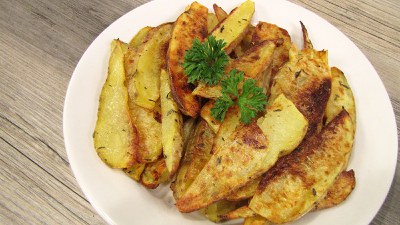Oven Baked Fries
2 large potatoes, cut into wedges
4 tsp. extra-olive virgin oil
½ tsp. salt
½ tsp. dried thyme (optional)
Preheat oven to 450 F. Mix the potato wedges with oil, salt and thyme (if using). Spread the wedges on a baking pan. Bake until browned and tender, about 20 minutes. Turn them once halfway through.
Makes five servings. Each serving has 180 calories, 5 g fat, 4 g protein, 32 g carbohydrate, 2 g fiber and 310 mg sodium.
Rosemary Roasted Potatoes
1 pound small, red potatoes
2 Tbsp. olive oil
½ tsp. crushed, dried rosemary
½ tsp. salt
Preheat oven to 400 F. Wash potatoes thoroughly. Cut in half. Arrange in shallow pan. Drizzle with olive oil and turn to coat well. Sprinkle with rosemary and salt. Stir to mix well. Bake uncovered, stirring occasionally, until tender (25 to 35 minutes).
Makes four servings. Each serving has 140 calories, 7 g fat, 3 g protein, 20 g carbohydrate, 2 g fiber and 290 mg sodium.
Garlic Mashed Potatoes
1 pound red potatoes
½ c. skim milk
2 large garlic cloves, chopped
½ tsp. white pepper
1 Tbsp. fresh chives, chopped (optional)
Peel potatoes, cut into quarters and place in cold, salted water for about 15 minutes. Drain in colander, rinse well and place in a 2-quart saucepan containing 2 cups of boiling water. Cover and cook for 20 to 25 minutes or until tender. Meanwhile, have milk warming over low to medium heat. Add garlic to hot milk and simmer until garlic is soft, about 20 to 25 minutes. Remove cooked potatoes from heat, drain in colander, replace in saucepan and cover to keep warm. Add milk-garlic mixture and white pepper to potatoes, mash with potato masher and then whip with an electric mixer. If desired, garnish with chopped fresh chives.
Makes four servings. Each serving has 100 calories, 0 g fat, 3 g protein, 22 g carbohydrate, 3 g fiber and 20 mg sodium.
Key to abbreviations
c. = cup oz. = ounce
tsp. = teaspoon g = gram
Tbsp. = tablespoon mg = milligram
Funding for this publication was made possible by the U.S. Department of Agriculture’s Agricultural Marketing Service through grant AM170100XXXXG005.
Its contents are solely the responsibility of the authors and do not necessarily represent the official views of the USDA.
For more information on this and other topics, see www.ag.ndsu.edu

